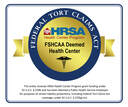
CLARKSBURG — Flu cases have decreased in the state and across the nation, but medical professionals warn that the threat is ongoing.
“West Virginia is no longer considered widespread, which is good, but Virginia, Pennsylvania and Kentucky are still … widespread, so we’re not out of it yet,” said Dr. Mark Povroznik of United Hospital Center.
According to Povroznik, about 21 percent of flu tests given to patients with flu-like symptoms in the nation are coming back positive, compared to about 38 percent at the peak of flu season. That rate is down to 14 percent at UHC, he said.
MedExpress facilities have seen similar trends nationwide, according to Dr. Dena Nader, regional medical director for MedExpress. The provider has seen a 21 percent decrease in cases in its 250 urgent care centers in 19 states. “We have seen the downward turn we’ve been waiting on over the last week,” Povroznik explained.
Dr. Kara Siford of Community Care of West Virginia cautioned that, although cases have decreased, “we are still seeing quite a few cases.”
According to Povroznik, about 8.5 percent of visits to the emergency room were for influenza-like illness at the peak of the epidemic. That total is at less than 5 percent now.
“Our goal is to get it below 2 percent. It sounds like you’re splitting hairs, but it’s not. When influenza illness accounts for greater than 2 percent, your likelihood for transmission is high. We’re starting to see the decline, but we’re not below that threshold yet that we can say the risk of acquiring it has dropped significantly. But we’re heading there,” Povroznik said.
In two weeks, professionals should have a better grasp of whether the epidemic is going to continue to decline or whether there will be a secondary spike in cases, he said.
A second spike can occur when the community gets complacent, according to Povroznik.
Therefore, it is still imperative for people to practice preventative measures to decrease risk of contracting influenza.
Siford cautioned that it could still be several weeks before flu season is completely over.
“The good habits that you’ve exercised during this epidemic should continue throughout the year and become a preventative habit for you as individuals,” Povroznik said.
“Take preventative actions, like washing your hands frequently and staying away from people who are sick to help stay well this winter. It can also be helpful to wipe down frequently used surfaces, like your cell phone, to avoid the spread of germs. Also, since droplets from coughs and sneezes can travel and live on surfaces for up to 48 hours, it’s important to remember proper cough etiquette,” Nader advised.
“Blow your nose and cough into a tissue — and if a tissue isn’t available, cough and sneeze into your upper arm or sleeve. Wash your hands after coughing, sneezing and blowing your nose, and turn away from people when you’re coughing or sneezing,” Nader advised.
The vaccine is also still an option for anyone who has not had the flu.
“The dominant strain — H3N2 — tends to make for a more severe disease, particularly among older people and people with underlying illness. That’s why it’s important for everyone, but especially seniors, pregnant women, children and individuals with asthma, diabetes and lung disease to get their flu shot as they are at increased risk for complications from influenza,” Nader said.
It also makes it imperative that those with flu-like symptoms seek medical care at the first sign of symptoms, Siford said.
“The Tamiflu medication that we have, the antiviral medication, is most effective if we can give it within the first 24 to 48 hours of symptom onset. It can be very helpful in reducing the duration of symptoms and the severity of symptoms if we can get that onboard,” she said.
According to Povroznik, the state has yet to release mortality statistics for this flu season.
Staff Writer JoAnn Snoderly can be reached at 304-626-1445 or by email at [email protected].
To read the story with graphics, please visit:
https://www.wvnews.com/theet/news/west-virginia-seeing-decrease-in-flu-cases/article_dbf68ece-e5b3-57de-a8e7-3cac71f7432a.html

 RSS Feed
RSS Feed









